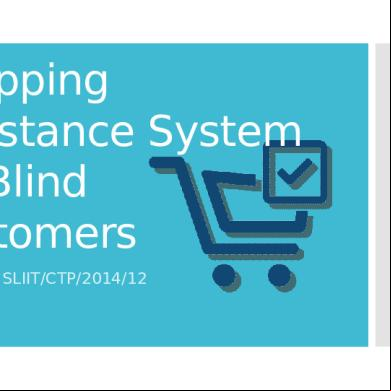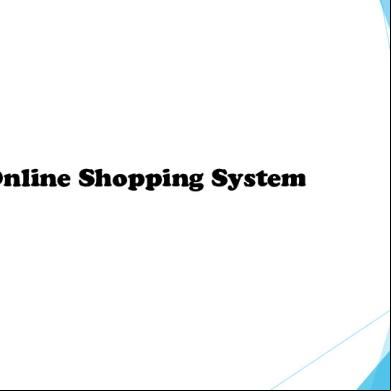Shopping Assistance System For Blind Customers 6v5q5l
This document was ed by and they confirmed that they have the permission to share it. If you are author or own the copyright of this book, please report to us by using this report form. Report 3i3n4
Overview 26281t
& View Shopping Assistance System For Blind Customers as PDF for free.
More details 6y5l6z
- Words: 696
- Pages: 16
Shopping Assistance System for Blind Customers Project ID: SLIIT/CTP/2014/12
Our Vision….. Bring the visually impaired customers to Super Market shopping culture..
Introduction Why “ Vision impaired customer assistance system”? “Estimated statistics reveal that 285 million people are visually impaired and out of this number, 39 million people are totally blind”
Shopping behavior analysis Function Name
Function Description
F1
Shopping list preparation
F2
Getting to super market
F3
Finding products in store
F4
Getting to cash s
F5
Paying
F6
Getting to exit
F7
Getting home
Our solution Integration of Three systems -Navigation System This function involves identifying the correct good shelves that the customer need, by comparing the shelf’s ID number with customer inputs. The ID is given to each shelf using RFIDs. The RFID is captured by a RFID reader and that information is possessed by a mobile application, for further comparison. Depending on the position of a customer the system will deliver the relevant shelf name as a voice recording to customer.
Item selecting Soon after the customer receives the message that he is ing the correct shelf, he should stop and start selecting. For reading purpose the customer is given hand held RFID reader. Thus as mentioned in earlier function, each good is uniquely identified by a RFID chip and a recording will be played, uttering goods name each time customer reader the ID from reader. Collision detecting System During the navigation period the customer is who control the navigation path of cart depending on the audible instructions. Thus there should be a way to identify barriers in front of the cart. We intended that again best way to solve this, is to let the customer to know about the barrier in front of him using a
Background -We found out several attempts on this issue. RoboCart
RoboCart was our first accessible blind shopping project that started in early 2004 [1] at the Computer Science Assistive Technology Laboratory of Utah State University (USU CSATL). The objective was to design a robotic supermarket shopping assistant for blind shoppers. A long-term collaborative agreement was negotiated with Lee's Market Place to grant us access to its supermarket in Logan, Utah for experimental purposes.
GroZi GroZi is an accessible shopping project at UC San Diego : 1) an accessible web site for blind and VI s to create grocery shopping lists in the comfort of their homes; 2) computer vision software for recognizing products and signs in stores; and 3) portable devices that can execute computer vision algorithms and give the haptic and verbal IBM patent In 2002, IBM acquired a patent on a method to provide VI shoppers with location and item identification at sites that have barcode labels. The patent describes a portable unit that assists VI shoppers at stores by providing them, through speech synthesis, with information on their locations from various barcode labels.
Goals & Objectives Goals bring the Blind Customers to regular super market shopping environment applicable any blind customer despite the age, gender, profession and knowledge. to integrate each sub systems that will results high efficiency
Objectives reach project mile stones with in the periods specified in project plan. Keep the minimum project cost level under 20 000 Deliver the project on 10th November 2014
Procedures Project development Phases Requirements gathering Feasibility Study Design Implementation
Project Planning
Task
Start
Finish
July
August
Requirement
2014-07-07
2014-07-21
Design
2014-07-22
2014-08-01
Implementation
2014-08-02
2014-09-30
Testing and
2014-09-01
2014-10-30
September
October
Analysis
debugging
Organizing Task
Star t
Finis h
Gamag e
Require ment Analysis
2014 -0707
2014 -0721
Design
Collision Detection Sys
2014 -0722
2014 -0801
Android App Impleme ntation
Testing and debuggi ng Docume ntation
Collision Detecting sys hardware
2014 -0802
2014 -0930
Prami th
Anurad ha
Lilan
PIC program ming
Android app
Database impleme ntation
RFID devices integratin g
2014 -0901
2014 -1030
Evaluation Performance matrices Cost Efficiency Time Accuracy Observing performance matrices continuously
Budget
Budget Device
Price
RFID reader
3000.00
RFID tag
150.00
PIC microcontroller
2000.00
Portable battery
2000.00
Alarm System
700.00
Total
8850.00
Thank You!
Our Vision….. Bring the visually impaired customers to Super Market shopping culture..
Introduction Why “ Vision impaired customer assistance system”? “Estimated statistics reveal that 285 million people are visually impaired and out of this number, 39 million people are totally blind”
Shopping behavior analysis Function Name
Function Description
F1
Shopping list preparation
F2
Getting to super market
F3
Finding products in store
F4
Getting to cash s
F5
Paying
F6
Getting to exit
F7
Getting home
Our solution Integration of Three systems -Navigation System This function involves identifying the correct good shelves that the customer need, by comparing the shelf’s ID number with customer inputs. The ID is given to each shelf using RFIDs. The RFID is captured by a RFID reader and that information is possessed by a mobile application, for further comparison. Depending on the position of a customer the system will deliver the relevant shelf name as a voice recording to customer.
Item selecting Soon after the customer receives the message that he is ing the correct shelf, he should stop and start selecting. For reading purpose the customer is given hand held RFID reader. Thus as mentioned in earlier function, each good is uniquely identified by a RFID chip and a recording will be played, uttering goods name each time customer reader the ID from reader. Collision detecting System During the navigation period the customer is who control the navigation path of cart depending on the audible instructions. Thus there should be a way to identify barriers in front of the cart. We intended that again best way to solve this, is to let the customer to know about the barrier in front of him using a
Background -We found out several attempts on this issue. RoboCart
RoboCart was our first accessible blind shopping project that started in early 2004 [1] at the Computer Science Assistive Technology Laboratory of Utah State University (USU CSATL). The objective was to design a robotic supermarket shopping assistant for blind shoppers. A long-term collaborative agreement was negotiated with Lee's Market Place to grant us access to its supermarket in Logan, Utah for experimental purposes.
GroZi GroZi is an accessible shopping project at UC San Diego : 1) an accessible web site for blind and VI s to create grocery shopping lists in the comfort of their homes; 2) computer vision software for recognizing products and signs in stores; and 3) portable devices that can execute computer vision algorithms and give the haptic and verbal IBM patent In 2002, IBM acquired a patent on a method to provide VI shoppers with location and item identification at sites that have barcode labels. The patent describes a portable unit that assists VI shoppers at stores by providing them, through speech synthesis, with information on their locations from various barcode labels.
Goals & Objectives Goals bring the Blind Customers to regular super market shopping environment applicable any blind customer despite the age, gender, profession and knowledge. to integrate each sub systems that will results high efficiency
Objectives reach project mile stones with in the periods specified in project plan. Keep the minimum project cost level under 20 000 Deliver the project on 10th November 2014
Procedures Project development Phases Requirements gathering Feasibility Study Design Implementation
Project Planning
Task
Start
Finish
July
August
Requirement
2014-07-07
2014-07-21
Design
2014-07-22
2014-08-01
Implementation
2014-08-02
2014-09-30
Testing and
2014-09-01
2014-10-30
September
October
Analysis
debugging
Organizing Task
Star t
Finis h
Gamag e
Require ment Analysis
2014 -0707
2014 -0721
Design
Collision Detection Sys
2014 -0722
2014 -0801
Android App Impleme ntation
Testing and debuggi ng Docume ntation
Collision Detecting sys hardware
2014 -0802
2014 -0930
Prami th
Anurad ha
Lilan
PIC program ming
Android app
Database impleme ntation
RFID devices integratin g
2014 -0901
2014 -1030
Evaluation Performance matrices Cost Efficiency Time Accuracy Observing performance matrices continuously
Budget
Budget Device
Price
RFID reader
3000.00
RFID tag
150.00
PIC microcontroller
2000.00
Portable battery
2000.00
Alarm System
700.00
Total
8850.00
Thank You!










